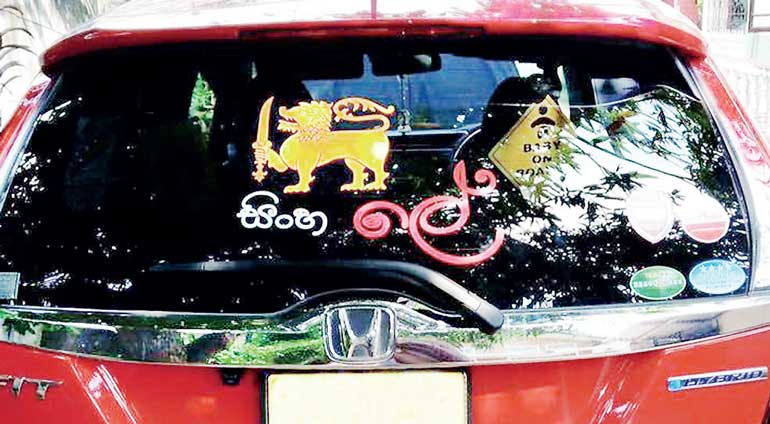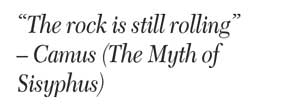Tuesday Dec 09, 2025
Tuesday Dec 09, 2025
Thursday, 14 January 2016 00:00 - - {{hitsCtrl.values.hits}}
 The sudden sprouting of the ‘Sinha Le’ (Blood of the Lion) movement is almost a remake of the sudden sprouting of the Bodu Bala Sena (BBS)
The sudden sprouting of the ‘Sinha Le’ (Blood of the Lion) movement is almost a remake of the sudden sprouting of the Bodu Bala Sena (BBS)
 By Tisaranee Gunasekara
By Tisaranee Gunasekara
A song posted on YouTube comparing President Maithripala Sirisena to ancient kings of Polonnaruwa gave rise to a storm of social media protests and was removed within hours. Parliamentarian Hirunika Premachandra was arrested for her alleged involvement in the Kolonnawa abduction.
It would have been better if that hagiographic video was never made. It would have been better if Premachandra didn’t try to take the law into her hands. But the song was killed and the AG ordered Premachandra’s arrest. Such correctives would have never happened under Rajapaksa rule.
One year on, the situation is not as good as we hoped for, but infinitely better than what went before.
President Sirisena is not immune to the germs of grandeur. He too might like to rule untrammelled and long, to become a king in all but name. But given the actual disposition of forces and balance of power, there is very little he can do to turn those yearnings into reality. His hold over the SLFP is tenuous at best and his survival depends on continued support of the UNP. The powers of the presidency have been clipped by the 19th Amendment. At least a segment of the public is vigilant and assertive as never before; and they can air their opinions on any and all subjects without fear.
The restoration of democracy has been a key achievement of the January 8th victory. The task is far from complete and the risk of regression remains, but that is a normal condition even in advanced democracies. President Sirisena governs rather than rules give or take an occasional antic. The government he presides over does not revolve around his family; it is the most inclusive and collegiate administration in living memory. He has hinted that he might remain in politics after he retires from the presidency in 2020, but dynastic succession is not something we need to worry about today. No individual holds too much power now; therefore the harm they can do by abusing power is also limited.
And there is a very real possibility that a more democratic constitution will be drafted and promulgated in a democratic manner.
Given what was, these are changes to be happy about.
Some things old, some things new
In the one year since the momentous defeat of the Rajapaksa project much has changed and much (alas) remains the same. We still have a mammoth cabinet (which continues to grow); but ministers don’t whiz around in convoys as if they own the earth. Corruption and waste remain, but on a lesser scale and at a lower intensity. The rule of law is yet to be completed but impunity no longer reigns. Politicians still abuse power but the media can report and the people can protest, without fearing for their lives. Police still attack demonstrators and kill suspects and non-suspects, but they can no longer get away with such abuses.
Politicians remain as venal, corrupt and power-hungry as ever, but the less unintelligent ones have become more aware of the new limits on power and its use. This became particularly evident when President Sirisena tried to play at cultural policing with his puerile remarks about bra-throwing and whipping. He was clearly unhappy about the veritable storm of protests which greeted his ill-advised comments; he might even have wished he could mute those voices of criticism and ridicule. But he cannot, he knows he cannot and he stops at pique.
Ethno-religious racism is far from dead, but it has been banished from centre stage to the margins of polity and society. Many Sinhalese, Tamils and Muslims still mistrust and perhaps even fear each other, but the danger of a new conflagration has dwindled, for now.
The new Government inherited an economy caught in a debt trap. Instead of acknowledging this reality, the administration has adopted a Micawberish policy of denial and unrealistic optimism. Like its predecessor, it is becoming addicted to borrowing and spending, and not on essentials either, if the reported purchase of fighter jets (whatever for?) is correct. This road is likely to come to a dead-end soon; and the danger of the Government veering in the opposite extreme and imposing even more hardships on the already burdened populace is very real. Economics was the Achilles Heel of the Rajapaksas. This might become true of the new administration as well.
Political scientist and historian Archie Brown in ‘The Myth of the Strong Leader’ introduces two leadership categories – the redefining leader and the transformational leader. Professor Brown describes redefining leader as one who stretches ‘the limits of possible in politics and radically alters the political agenda’. That was the Himalayan task the Lankan opposition was confronted with during the last presidential election. It had to convince enough voters that the Rajapaksas should and could be defeated.
The opposition won because it was able to face that challenge successfully.
The Sirisena-Wickremesinghe administration’s performance would have been far more positive had it not abandoned this redefining role in its very first year in power. In such seminal areas as corruption, waste, nepotism and justice, the administration displays a disturbing penchant for aping the Rajapaksas.
There are no ethnic or religious crimes. Minister Bathiudeen and his supporters are reportedly guilty of encroaching on the Wilpattu sanctuary, but degradation of environment is not a Muslim crime. Nor is it a Sinhala-Buddhist or a military crime, despite the fact that 15 soldiers were caught this week felling trees in the Wilpattu sanctuary. The destruction of environment is a human crime. Similarly there are no Rajapaksa crimes. The Rajapaksas committed many crimes, but they are crimes even if committed by the most fervent opponents of the Rajapaksas. There is no better vindication of the Rajapaksas than the Sirisena-Wickremesinghe administration continuing with Rajapaksa policies and practices.
The Rajapaksa way didn’t even work for the Rajapaksas. It will certainly not work for the Sirisena-Wickremesinghe administration. If the government takes clear steps to minimise corruption, waste, nepotism and abuse in its own ranks, if it abides by its own oft-declared principles, the populace might be willing to back it, despite growing economic hardships. But if the government allows its own to ape the worst practices of the previous regime and act like so many tin-pot dictators, come economic hardships the populace will begin to look elsewhere.
And in the Sinha Le banner of the Rajapaksas they might misperceive the way to another promised land.
The Sinha Le Madness 
The sudden sprouting of the ‘Sinha Le’ (Blood of the Lion) movement is almost a remake of the sudden sprouting of the Bodu Bala Sena (BBS).
The Rajapaksas used minority-phobia as a political tool to distract the attention of Sinhala-Buddhists from growing economic ills. The creation of the ‘halal issue’ was an excellent case in point. The BBS and others of its ilk were used by the then ruling family to addle Sinhala-Buddhist minds with fear and hate and to threaten the minorities into subservience.
The Sinha Le initiative is another Rajapaksa freak show with a similar purpose – incite minority phobia among Sinhala-Buddhists and use that as a pathway for the Rajapaksas to regain lost power. This week, Gotabhaya Rajapaksa publicly pronounced the need for a new political party (http://asianmirror.lk/top-news/item/14014-gotabaya-rajapaksa-reveals-intention-of-forming-new-party-of-the-people). What we are witnessing is the birth of a third force – or perhaps a second-and-a-half force, because it is still located within the SLFP – which is neither leftist nor progressive. It uses a dose of anti-imperialist rhetoric to hide its racism and obscurantism.
When Mahinda Rajapaksa, a self-proclaimed child of 1956, became the President, Sinhala-Buddhist supremacists got a government that was theirs in every sense of the word, a government of ‘Sinha Le’ tough guys. Mahinda Rajapaksa was the leader the Sinhala supremacists always dreamt of but never had. This constituency is rather like the American hard right backing Donald Trump or the French extremists supporting Marine Le Pen. They share the Rajapaksa anger at the 8 January defeat. Like the Rajapaksas they too dream of making a comeback. They need the Rajapaksas just as the Rajapaksas need them. It is a mutually beneficial alliance which is likely to become stronger as the economy weakens.
The Rajapaksas made one premature attempt to regain power and failed. Now they seem to be playing a waiting game. Trying to redefine the political centre in Sinhala-Buddhist supremacist terms is part of that slow politico-ideological build up, as is the re-legitimisation of the cult of the strong leader. That was what Namal Rajapaksa was trying to do when he publicised a picture of his father hanging upside down like a bat during a yoga session.
If the Sirisena-Wickremesinghe administration fails to handle the economy, the resultant crisis will be depicted as a problem created by the ‘privileged minorities’ to beggar the ‘disadvantaged majority’. A variety of National Socialism (based on an apocryphal politico-economic analysis of minority capitalism exploiting the poor Sinhalese) has always been part of Lankan leftism. It is this hoary old tradition the Rajapaksas and their allies are trying to resurrect.
The huge parliamentary majority currently enjoyed by the Sirisena-Wickremesinghe administration is an ephemera, something which can change in a matter of weeks if not days. All those who pole-vaulted to gain a position or escape from prosecution will jump right back, the moment the Government becomes mired in the economy.
The Government has two key political tasks to perform – a new, more democratic constitution and a political solution to the ethnic problem. The Rajapaksa clique will oppose both measures tooth and nail. The ‘country is in danger’ scream has become shriller. As the parliament gets down to the task of drafting a new constitution, the Rajapaksa cohorts will try to subvert it from within and oppose it from without.
Sinha Le is a reference to the Mahawamsa myth about the origin of the Sinhala people. That inane tale about a union between a lion and a princess and the equally apocryphal story about their grandson (a product of an incestuous union between a parricide brother and a sister) receiving the long-distance blessings of the Buddha have been used by everyone from anti-devolution politicians to hard-line monks, from academics to military men, from novelists to lay people, to justify Sinhala Buddhist supremacism and to oppose any political concessions to the minorities. The revival of that blood-and-faith nationalism is a sign that the Rajapaksas are planning to ignite a racist conflagration and come to power in its wake.
The end result will be a disaster for all concerned, including Sinhala-Buddhists. Extremists and fanatics begin with destruction and end with self-destruction.
That is why the Sirisena-Wickremesinghe administration must reclaim its role as redefining leaders. The Rajapaksa attempt to shift the political centre to the right, to render ethno-religious racism respectable again needs to be resisted. But this cannot be done successfully unless the government tries to honour the basic principles of good governance. Good governance is not a label to affix on oneself for perpetuity but a set of practices which needs to be reaffirmed daily.
If the Government ceases to mishandle the economy and takes visible, tangible steps to honour its own commitments, the Rajapaksa plan fail and Sri Lanka would be able to continue her journey to a more democratic, inclusive and tolerant future. The sort of future we hoped for when we voted for a change on 8 January.
If…